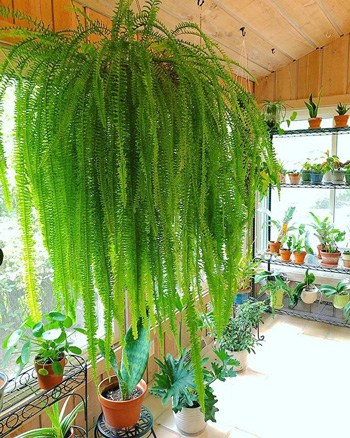
Staghorn ferns are statement pieces, especially if mounted on a slab of wood. To take care of staghorn ferns indoors or on patios, there are a few essential considerations. First, these unique plants require bright, indirect light, so place them near a window with filtered sunlight. Avoid exposing them to direct sunlight, as it can scorch their delicate fronds. Staghorn ferns thrive in humid environments, so it's beneficial to mist them regularly or provide a humidifier nearby. Additionally, these ferns prefer well-draining soil, so use a mixture of peat moss, orchid bark, and perlite to create a suitable growing medium. Watering is crucial but can be a bit tricky. It's best to water staghorn ferns by soaking their root ball in water for about 15-30 minutes, ensuring thorough hydration, and then allowing the excess water to drain. Avoid letting them sit in standing water as it can lead to root rot. Lastly, provide a moderate amount of fertilizer during the growing season to support healthy growth. By following these guidelines, you can enjoy the stunning beauty of staghorn ferns indoors or on your patio.


Boston ferns are the cornerstone in indoor ferns--a trusty staple you can't go wrong with. They thrive in indirect, bright light. Place them near a window with filtered sunlight, ensuring they are not exposed to direct sunlight, which can scorch their delicate fronds. Boston ferns prefer a consistently moist environment, so it's important to water them regularly. Keep the soil evenly moist, but be cautious not to overwater, as it can lead to root rot. Mist the fronds daily or provide a humidifier to maintain the humidity levels they prefer. These ferns appreciate higher humidity, so consider placing them in a bathroom or kitchen where the humidity tends to be naturally higher. Additionally, provide them with a well-draining potting mix that retains moisture without becoming waterlogged. Fertilize Boston ferns every two to four weeks during the growing season using a balanced, water-soluble fertilizer at half strength. With proper lighting, watering, humidity, and fertilization, you can enjoy the beauty of healthy and vibrant Boston ferns in your indoor space.